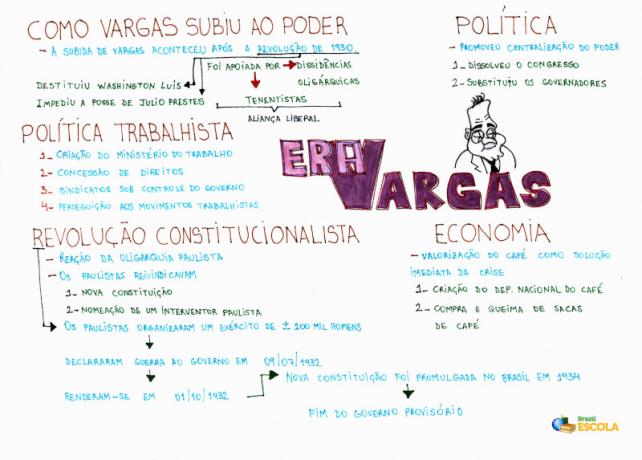THE It was Vargas it was the period of Brazilian republican history in which the president of the Republic was Getúlio Dornelles Vargas, who uninterruptedly governed Brazil between 1930 and 1945. Later, Vargas took yet another term between 1951 and 1954. Vargas' passage as president represented a new was in the country's history in the face of changes in Brazilian society through the socioeconomic and political measures adopted by their governments.
Vargas's arrival at the presidency represented a political break with the Old Republic. THE 1930 revolution it put an end to the political dominance of the São Paulo coffee oligarchy in charge of the Federal Government, thus ending the so-called coffee with milk policy.
The Vargas era was divided into some phases. The first concerns the Provisional Government, which occurred between the years of 1930 and 1934. This was the period of reorganization of the national state and preparation for the creation of a new Constitution. However, the delay in creating a Constituent Assembly led the oligarchy and industrialists in São Paulo to wage war against the federal government. The Constitutionalist Revolution of 1932 was one of the facts that most marked this phase and pressed for a new Constitution to be drafted.
With the emergence of the 1934 Constitution, a new phase of the Vargas Era began. the period of constitutional government started in 1934 and ended in 1937. It was a period characterized by the maintenance of a liberal democratic government regime. This period was also characterized by conflicts between the different groups that participated in the political scene in the 1930s. Conflicts between communists and integralists, in addition to the fierce opposition of the former to the government of Getúlio Vargas, led to the outbreak of the so-called Communist Intentona of 1935. The movement was contained with numerous arrests and harsh repression, also serving as an argument for Getúlio Vargas to carry out a new coup d'état.
The closing of Congress in November 1937 and the imposition of a new Constitution began the third phase of the Vargas Era, known as new state, which was in force between 1937 and 1945. The Estado Novo period constituted a Vargas dictatorship, strongly influenced by the fascism that was in force in Europe. The end of the Estado Novo occurred simultaneously with the end of World War II, due to Vargas's inability to remain in power after 15 years of government.
Mind Map: Era Vargas

*To download the mind map in PDF, Click here!
The Vargas era also represented the efforts to carry forward the capitalist modernization of Brazilian society. There were large investments for the industrialization of the national economy, with emphasis on the creation of a base industry in the steel industry (Cia. Siderúrgica Nacional, CSN), mining (Cia Vale do Rio Doce) and energy (Cia Hidrelétrica do São Francisco). Thus, the process of strengthening capitalism in Brazil relied on the State and the managers who controlled it as the main instrument. As the only institution with the accumulation of capital necessary for investments, the State and the managers who ran it relegated the still incipient bourgeoisie to the background in this process. Brazilian. The State's effort was mainly to create the general conditions of production for the country's industry.
Do not stop now... There's more after the advertising ;)
It was still necessary to create legislation that would guarantee some rights to the developing working class in the country, intending, in this way, to contain the process of workers' struggle verified in the 1910s and 1920. The creation of the Ministry of Labour, in 1930, and the enactment of the Consolidation of labor laws (CLT), in 1943, were the main actions to guarantee minimum rights to workers. Vargas also used the State as controller of workers' union action and also to establish the exploitation mechanisms to be used by capitalists, creating specific laws for this, in order to overcome the class struggle, creating a supposed harmony Social. It was the constitution of Vargas' Corporatist State.
Other institutions that stood out in the modernization process were the Administrative Department of the Public Service (DASP), created to form the state civil service, and the Department of Press and Propaganda (DIP), to ensure censorship of the press and artistic expression, as well as to carry out the government advertising.
The struggle against dictatorships in Europe during World War II created an internal contradiction in Brazil. It was necessary to end the Vargas dictatorship. The political situation and pressure from the military led Vargas to resign in October 1945, putting an end to what historians call the Vargas Era.
In 1951, Vargas would still return to power, this time through direct presidential elections. There was a strong nationalist discourse and the objective to further expand the industrialization process. The “Oil is ours” campaign and the creation of Petrobras stood out. However, strong political opposition, mainly from the National Democratic Union (UDN) and Carlos Lacerda, created an unsustainable situation for Vargas. On August 24, 1954, the president committed suicide. Known by some as the father of the poor, and by others like the mother of the rich, Getúlio Vargas put an end to participation in the political scene in Brazil, stating that he left “life to enter history”.
––––––––––––––––
*Image Credit: CPDOC/FGV
By Me. Tales Pinto
*Mental Map by Daniel Neves Silva
Graduated in History
Would you like to reference this text in a school or academic work? Look:
PINTO, Tales of the Saints. "What was the Vargas Era?"; Brazil School. Available in: https://brasilescola.uol.com.br/o-que-e/historia/o-que-e-era-vargas.htm. Accessed on June 27, 2021.



